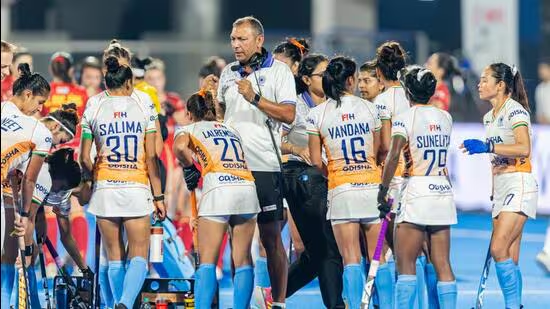
Harendra Singh Faces Daunting Task in Reviving Indian Women’s Hockey Team Amidst Performance Slump…see more…
Harendra Singh, one of India’s most seasoned and passionate hockey coaches, has returned to helm the Indian women’s national hockey team at a time when the squad finds itself at a crossroads. Once hailed as a rising powerhouse in world hockey, the team has stumbled in recent years, prompting Hockey India to turn to the experienced Harendra to guide the squad back to its former promise. The road ahead, however, is fraught with challenges—both on and off the field.
A Team in Decline
The Indian women’s hockey team made headlines in 2021 when it defied the odds to reach the semifinals at the Tokyo Olympics, finishing a historic fourth. That spirited run under coach Sjoerd Marijne had raised expectations and inspired a new generation of female hockey players across the country. But since then, the team has struggled to maintain consistency.
Under Janneke Schopman, who took over after Marijne’s departure, the team showed glimpses of potential but failed to build sustained momentum. A disappointing performance in the 2022 World Cup, where India finished ninth, and an underwhelming Pro League campaign earlier this year were alarming signs. The final straw came during the Olympic qualifiers, where the team failed to book a spot for Paris 2024—deemed a major setback.
Schopman’s abrupt resignation earlier this year left Hockey India scrambling for a leader who could rebuild not just tactics and skill, but morale. Enter Harendra Singh.
Harendra’s Return: A Familiar Face with Unfinished Business
Harendra is no stranger to Indian hockey. A Dronacharya awardee, he has previously coached both the junior and senior men’s teams, as well as the women’s team. In 2017, he led the Indian junior men’s team to a World Cup title—a feat that cemented his reputation as a sharp tactical thinker and motivator.
His last stint with the women’s team, in 2017-18, was short but productive. India won the Asia Cup under his leadership, qualifying for the 2018 World Cup in style. However, politics and internal dynamics reportedly led to his exit. Many believe he deserved a longer run then—and now he has a second chance.
This time, Harendra returns with the freedom to build from scratch. But that freedom also comes with weighty expectations.
Major Challenges on the Horizon
The first challenge Harendra must confront is mental resilience. After a string of disappointing results and the heartbreak of missing out on the Paris Olympics, the team is emotionally depleted. Senior players like Savita Punia, Vandana Katariya, and Neha Goyal have spoken candidly about the psychological toll of recent failures.
Rebuilding confidence will be key. Harendra is known for his fiery passion and motivational approach—qualities that could be vital in restoring belief in the dressing room. “You don’t just coach players—you coach minds,” he said in his first press briefing after taking charge again. “We will get back our identity.”
Next is fitness and intensity. Analysts and former players have often pointed out the lack of stamina and sharpness in India’s game, especially against European teams that play high-speed, high-press hockey. Harendra’s training regimens are expected to be rigorous, with a renewed focus on physical conditioning.
Then comes tactical discipline and innovation. India’s defensive structure has looked porous, and transitions from midfield to attack have been inconsistent. Harendra is expected to bring tactical clarity—something he was lauded for during his time with the junior men’s side. Early signs suggest that a new 4-3-3 system might be tested during the team’s upcoming tour of Spain.
Finally, team selection and generational change could be tricky terrain. With several veterans nearing retirement, Harendra must balance experience with youth development. The junior pipeline, though promising, lacks international exposure. He has already hinted at a talent-scouting initiative involving zonal camps across India to identify the next batch of stars.
A New Cycle Begins
The good news for Harendra is that the next major international cycle offers time. With no Olympics this year, focus shifts to the 2026 Commonwealth Games, 2026 Women’s World Cup, and the 2028 Los Angeles Olympics. Hockey India is reportedly backing him with a long-term vision, giving him space to build a cohesive unit.
There is also a shift in support structures. The Sports Authority of India (SAI) has pledged increased resources for the women’s program, including better facilities, psychologist support, and exposure tours. Former stars like Rani Rampal are also being roped in to mentor the younger players.
Mixed Reactions in the Hockey Community
The reaction to Harendra’s appointment has been cautiously optimistic. Former captain Ritu Rani welcomed the move, saying, “Harendra sir brings fire and belief—something this team sorely needs.” Others, however, have warned that his aggressive coaching style might require delicate management in the modern era of athlete-sensitive coaching.
Critics point out that Harendra has not coached at the top level in recent years and will need time to adjust to evolving global trends in women’s hockey. But if there’s one thing Harendra is not short on, it’s belief.
The Road Ahead
India’s next major assignment is a four-nation invitational tournament in Valencia, Spain, later this year. That will serve as an early litmus test for Harendra’s impact. Fans and stakeholders alike will be watching not just for wins, but signs of revival—clarity of play, hunger, and unity.
The Indian women’s hockey team has been down before—and risen. With Harendra Singh back at the helm, the hope is that a new chapter is about to be written
—one of resilience, redemption, and renewal.
Leave a Reply